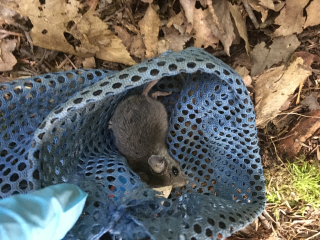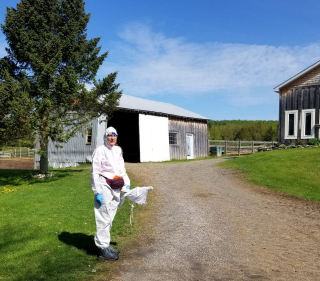
Millien Lab
Kirsten Crandall
Keeping pace with the risk and spread of disease: an interprovincial comparison of tick and mammalian host abundance and diversity in Ontario and Quebec
 As temperatures warm, infectious diseases carried by ticks (e.g., Lyme disease, Anaplasmosis, and Powassan Virus) are predicted to spread further into Canada due to the northward movement of the mammalian hosts transporting infected ticks. Over the past decade, the number of reported cases of infectious diseases transmitted by ticks in Canada has increased exponentially, with the greatest proportion of cases occurring in Quebec and Ontario.
As temperatures warm, infectious diseases carried by ticks (e.g., Lyme disease, Anaplasmosis, and Powassan Virus) are predicted to spread further into Canada due to the northward movement of the mammalian hosts transporting infected ticks. Over the past decade, the number of reported cases of infectious diseases transmitted by ticks in Canada has increased exponentially, with the greatest proportion of cases occurring in Quebec and Ontario.
 Disease transmission in this system relies on three key players: 1) the bacteria, 2) the vector (tick), and 3) the vertebrate host (bird or mammal). Continuous debate has centered on whether increased levels of vertebrate host diversity will increase or decrease the risk of disease, with a focus on the abundance of white-footed mice, the most competent carrier of tick-borne disease.
Disease transmission in this system relies on three key players: 1) the bacteria, 2) the vector (tick), and 3) the vertebrate host (bird or mammal). Continuous debate has centered on whether increased levels of vertebrate host diversity will increase or decrease the risk of disease, with a focus on the abundance of white-footed mice, the most competent carrier of tick-borne disease.
The effect of tick and host abundance and diversity on the spread and transmission of infectious disease has not been extensively studied in Canada. How does tick and host diversity and abundance affect disease risk? Where are the current and future hot spots for disease in Ontario and Quebec? My research uses several techniques such as small mammal trapping, trail cameras, morphometrics, and species distribution modeling to answer these questions. If at-risk populations are known in advance, preventative measures and active surveillance strategies may be put in place by health agencies to limit the number of future cases of infectious disease.
IMAGES by: Kirsten Crandall

|
Kirsten Crandall is a Joint Ph.D. candidate in the Millien lab at McGill University and the Kerr lab at the University of Ottawa. Her interest in disease ecology increased while completing her master’s degree at McGill University on the body size variation of the mammalian hosts of Lyme disease in North America. As a result of this research and the numerous accounts of people negatively affected by tick-borne diseases near her hometown of Montréal, Quebec, her interest peaked as to what factors might be driving the increased number of cases of infectious disease in Canada. She likes to integrate a wide variety of methods to disentangle this complex disease system. In her spare time, Kirsten enjoys participating in science communication through the Skype a Scientist program, volunteering at a local Montréal cat shelter, visiting natural history museums, and hiking some of Canada’s beautiful landscapes.
|

